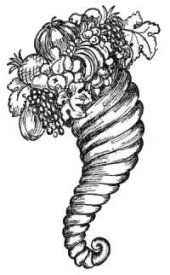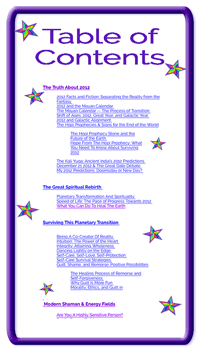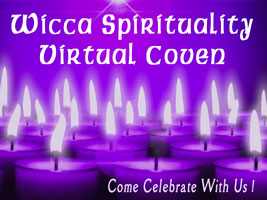How to Decorate for the Wiccan Sabbats
(Please Note: This material is protected by legal copyright)
A common question for beginners is how to decorate for the Wiccan Sabbats.
It makes sense that
Wiccans celebrate each Sabbat, on altars and in rituals, with specific colours, symbols, activities, and foods. All cultures and religions celebrates their special occasions with certain significant things.
So how do you know which decorations to use for which Sabbats?
Don't worry: it's not like there's a rulebook about this. The point is
not to follow the regulations that some supposedly-ancient Pagan set forth once upon a time. (I know you know better than that!

).
The point is, of course,
to mirror the blessings that the Earth gives us, at each Sabbat.
In a Nature religion, the Earth leads the way. Observing Nature, we can perceive for ourselves how Mother Earth celebrates each Sabbat. We join Her in celebration, by continuing Her themes. We decorate our altars and homes and celebrate with respect and gratitude for Nature's gifts of the moment.
Celebrating Sabbats As The Earth Does
The Earth is beautiful in every season, decorated with flawless perfection in each seasonal theme.

So we decorate our altars — and houses — to match, honouring Her different faces.
To put it plainly, Wiccans celebrate with the colours and items that the Earth gives us in each season...
- Imbolc/Brighid
New-leaf green, the purple and yellow of spring crocuses and daffodils, early flowers, seeds, milk products...
- Eostara
Bright spring greens, the delicate pastels of the fruit tree blossoms, eggs, fresh greens, wildflowers, pussy willows and budding branches...
- Beltaine
The fiery red of the new-coming Sun, spring greens and all the hues of the multitudes of flowers, candles, ribbons, antlers, mead...
- Midsummer
The bright blue of a summer sky, the bright gold of the summer sun, the deep green of full-grown leaves, berries and early fruits, flowers, roses and daisies, fruit juice...
- Lammas/Litha
The gold of the hot sun and ripe grain fields, heads of grain and ripe corn, sunflowers, bread, ale...
- Harvest Home/Mabon
The red and gold of Autumn leaves, nut-brown, horns and antlers, apples, wine, grapevines...
- Samhain
The orange of changing leaves and ripe pumpkins, the brown of bare earth, and black of bare trees against the long black sky, pumpkins, pomegranates...
- Yule
The green of evergreens, red of holly berries, white and silver of snow-blanketed landscapes, the gold of the newborn Sun, dried fruits, brandy, cookies and rich foods...
In addition, we use our intellect and imagination to perceive the quality of energy and correspondences with each Sabbat.
For example, Mabon — associated with herd animals and harvests — gives us a bounty of food, thus the promise of continuing life. So Mabon holds the energy of abundance and thanksgiving. And we decorate for this with Cornucopia — a horn-shaped baskets overflowing with produce and gifts of the season, symbolising the never-ending nourishment the Earth offers.
Of course, there are many more associations that Mabon holds for us, giving us a wide range of options for the symbols and decorations of the season.
Where Does Nature Draw The Line?
Wait a sec! (I can hear you thinking...) Lammas and Samhain are
also harvest festivals! So how can they be the same, yet different?
It can be very confusing for Wiccan beginners, the way themes and symbols overlap from one Sabbat to another. Fire for Brighid and Beltaine and Midsummer and Lammas; Spring celebrations at Imbolc and Eostara and Beltaine; green for Midsummer as well as its opposite, Yule....
Why does that thematic smearing happens? It's all
a matter of perspective!
There are different cycles at play in the Wheel of the Year, all overlapping and interweaving, such as ...
- the plants' cycle,
- the animals' cycle,
- the Sun's cycle,
- the Earth's cycle of the seasons,
- the Moon's cycle,
- and the human life cycle.
The progress of all these cycles are similar. They all proceed from inspiration to gestation to birth to maturity to fruition to contraction to death to purification, and around again. However, the time frames can be quite different: the Sun's cycle, for instance, is about 13 times longer the Moon's cycle.
So how you look at each Sabbat can be different from how another Pagan sees it.
Sabbat Symbology: Shades of Fey
Though there are surface similarities,
there are distinctions between each similar Sabbat as well.
Each of the three harvest Sabbats has a different focus, though they all celebrate the bounty of the harvest. And both Winter Sabbats (and to some degree Brighid/Imbolc and Eostara as well) represent new beginnings... what differentiates them is the LEVEL of the beginnings take place on.
Let's look at Samhain, since it's right around the corner for us Northerners.
At Samhain, in the seasonal cycle, the culmination of the previous year's growth is done, the final harvest of the year is complete, and the old plants will decay to compost or be dug up to prepare the land for new life.
This can be seen as a season of death, and often is, yet Wiccans count Samhain as a beginning: the beginning of the calendar year as well as the beginning of Winter.
Why? Samhain marks a beginning at the deepest level, the spirit level, the subconscious level — this is the root of or preparation for new life, just as menstruation begins a females' cycle: clearing the ground so new life can take root.
In the plants' cycle, it's clearly the time of death.
In the animals' cycle, it begins a time of scarcity, when many die, but it also is a time of gestation of new life, which will be born in the spring.
In the Sun's cycle, it's withdrawing to the longest, darkest nights, contracting into the Sun's version of death.
Of course, the Moon's cycle is much shorter and the human cycle is much longer than a year, so let's leave those out for now.
This isn't meant to confuse you, but to point out that
the lines between the Sabbats are blurred, inevitably. It's not just you.

Who can pinpoint the precise moment when life begins, or ends — for seasons or for humans?
Any such dividing lines are arbitrary: we make them up in our minds; such separations don't exist in Nature.
So How Do You Know What To Do?
If you guessed, "Follow the
Silver Rule" you'd be right! (I knew you'd get it!)
For your rituals and altars, use the symbols and correspondences that seem best to you. They may change year after year — for instance, a late Spring can really change the emphasis of an Imbolc celebration! And some things may become traditional for you, unchanging, year after year.
What's most important is that your seasonal celebrations resonate with Nature's rhythms, and with your heart and soul.
With Bright Blessings,


If you enjoyed this article, please Stumble it! Share the good stuff with other seekers.
Return from
How to Decorate for the Wiccan Sabbats to Silver Chalice E-Zine, Oct '14















